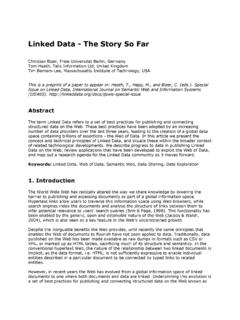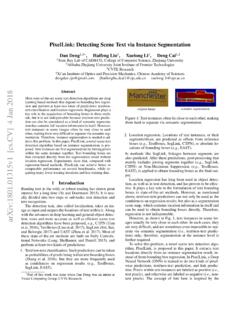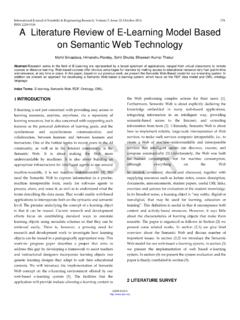Transcription of The Semantic- syntactic Scopes of Negation in English …
1 International Journal of Scientific and Research Publications, Volume 5, Issue 9, September 2015 1 ISSN 2250-3153 The Semantic- syntactic Scopes of Negation in English language Abdullah Nawash Abdallah Alnawaisheh Research Scholar, Aligarh Muslim University Abstract- This study attempts to present a clear picture about Negation scoops in semantic and syntactic features in the English language. It aims to describe the various aspects of sentential Negation by showing how Negation operates with different negative particles, and to illustrate the different positions of negations in English language It also attempts to shed light on the classification of the negative particles in English language according to their occurrences in sentences, , verbal and non verbal sentences and according to their semantic and syntactic positions in these sentences.
2 I. INTRODUCTION egation is a subject of variation across languages. Every language has its own syntactic , semantic and morphological devices expressing Negation . A great deal of research has been conducted by English and Arab Linguists on the similarities and differences of Negation in the two Language . Not only does this study tackle Negation in its wide sense, but also it focuses on a special aspect that is the semantic and syntactic scope of Negation in the English language. The goal of linguistic study is to discover the natures and facts of language, how it is acquired and how it functions? In recent years, much attention has been given to the question of how best to represent the structure of negative phrases and the nature of structures that negate themselves.
3 Negation data in various languages give many significant inferences about the underlying structural principles of Negation (Gleason, 2001). Negation is a universal linguistic notion. Indeed, it is one of the most basic elements in human mind that makes it an indispensible part of natural languages which are the tools for human thoughts. Every language has negative particles or expressions; statements that involve negative particles are called negative statements. As it is known, Negation is the opposite of affirmation; (positive and negative) one sentence or statement can be the Negation or denial of another. Thus, Negation is the process of making a sentence negative usually by adding negative particles within the structure. All languages have their own rules to change the statement from affirmative to negative.
4 According to Gleason (2001), this allows us to discuss what is not happening, or what we do not want. Bloom (1970) suggests that when children are learning a language, it is likely that they learn to produce and distinguish between two basic types of sentences: the affirmative and the negative. Negation is a fundamental linguistic phenomenon for the whole language system. It appears at different semantic and syntactic levels and has different purposes or meanings. Brustad (2000) investigated Negation in four Arabic dialects from a dialectological point of view. These four Arabic dialects are: Egyptian Arabic (EA), Moroccan Arabic (MA), Syrian Arabic (SA), and Kuwaiti Arabic (KA). She states that the four dialects have three strategies of Negation : verbal Negation , predicate Negation , and categorical Negation .
5 She has also defined categorical Negation in these dialects as that kind of Negation which is not restricted to a single entity or two of the category but includes the whole category which, according to her, does not mirror the mood of the speaker but has a normative aspect that is arrived after witnessing the Negation of a certain relationship, incident, member of a group, etc. II. OBSERVATIONS In this section, all types of Negation in English are to be previewed. Types of Negation in English and Arabic Auxiliary Negation There is a Negation rule in English : If we want to state that something is not true, we can form a negative sentence by adding the word not after the first auxiliary verb in the affirmative sentence. If there is no auxiliary verb in the affirmative sentence, as in the Present Simple and Past Simple tenses, we will add one with the word not after it.
6 When an auxiliary verb is added like that, the main verb must be in the infinitive form (no -s or -ed ending). Nowadays, when looking at a negative sentence, we usually see the auxiliary verbs with not in contracted forms, not in full forms. Full forms are used in very formal cases or when we want to emphasize. Contractions of negated auxiliary verbs in English are formed by reducing the negative particle not to n't, a clitic or suffix which is fused to the root verb form. Examples include isn't, aren't, wasn't, weren't (from be), hasn't, haven't, hadn't (from have), won't, wouldn't (from will), shan't, shouldn't (from shall), can't, couldn't (from can), mayn't, mightn't, and mustn't (from may). And we should remember that there is no standard contraction for am not . This is known in Linguistics as the "amn't gap".
7 All conjugations of be are subject to contraction even when used in a non-auxiliary sense. Ex: He isn t my teacher. ( be here isn t an auxiliary). In some dialects, have as a main verb is subject to contraction, in other dialects the Negation is realized by the insertion of auxiliary don't . Ex: I haven t a pen. (We rarely see this form.) I don t have a pen. (More popular). Here is a review of auxiliary negations including examples. In this table, we can see both contracted forms used in informal writing and speaking and full forms. Table 1: N International Journal of Scientific and Research Publications, Volume 5, Issue 9, September 2015 2 ISSN 2250-3153 Tense Negative element + contracted forms Examples Present simple Do+not = don t Does+not = doesn t I do not study. She doesn t study.
8 Past simple Did+not= didn t I didn t study. Present progressive Am+not (no amn t) Is+not = isn t Are+not = aren t I am not studying. He is not studying. We aren t studying. Past progressive Was+not = wasn t Were+not = weren t I wasn t studying. They were not studying. Present perfect Have+not = haven t Has+not = hasn t You haven t studied. She has not studied. Present perfect progressive Have+not+been = haven t been Has+not+been = hasn t been I have not been studying. She hasn t been studying. Past perfect Had+not = hadn t You hadn t studied. Past perfect progressive Had+not+been = hadn t been She hadn t been studying. Future simple Will+not =won t I won t study.
9 Future perfect Will+not+have = won t have He will not have studied. Conditional Would+not =wouldn t She wouldn t study. Conditional perfect Would+not+have =wouldn t have She wouldn t have studied. Modals can + not = can t or cannot (formal) should+not = shouldn t I can t study. I cannot study. We shouldn t study. Noun Phrase Negation Another way of changing an affirmative sentence into a negative sentence is to place a negative determiner or a restrictive quantifier before a noun, which is called noun phrase Negation . Determiner not. In English , there are several instances where not can grammatically negate the subject of a sentence. Ex: Not everyone can do this task. Not one thing was left untouched by the wrath of the tornado.
10 However, it doesn t mean that all noun phrases can be negated by not . For example, we can t say, Not Lan went to school yesterday. Based on various analyses of quantifiers (Barwise & Cooper, 1981; Keenan & Stavi, 1986; Tottie, 1991) and Negation (Horn, 1989, and those cited in Horn), Negation by not is only allowed when the denotation of the negated noun phrase has a readily definable interpretation; more specifically, the set of possible sizes for the set denoted by the negated noun phrase must be a continuous range of values. We can see more clearly with examples in the following table: Table 2: Example sentences demonstrating when it is grammatical (or interpretable) to negate a noun phrase with not . Grammatical Ungrammatical 1.
















